The 15 Worst Things About The Hitchhiker’s Guide to the Galaxy Movie
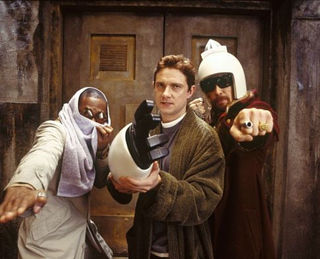 |
?“Hitchhiker’s by its very nature has always been twisty and turny, and going off into every direction. A film demands a certain shape and discipline that the material just isn’t inclined to fit into.” – Douglas Adams
To badly paraphrase Douglas Adams, when The Hitchhiker’s Guide to the Galaxy movie was released in 2005 it made a lot of people very angry and has been widely regarded as a bad move. Or at the very least a divisive one. Six years after its release and good chunk of Adams’ fanbase still regard the film as a disaster. Admittedly, there are some fun things about the movie: The introduction to the guide floating in space is breathtaking, the original Marvin cameo makes me giddy, the production design is wonderful and Martin Freeman and Bill Nighy own their roles — underwritten though they may be. Maybe you love this movie. If so, good for you. I wish I felt the same way. Instead, the film has haunted me for the better part of a decade as a jumble of bad pacing and artistic compromise after compromise. You see, I wanted nothing more than to enjoy a Hitchhiker’s Guide to the Galaxy movie after what felt like a lifetime of waiting (I am currently clinging to the vague hope that there will be a reboot with a different creative team). But what we ended up with pains me so greatly that I am writing today’s Daily List as a way to heal. If you share my views, maybe this analysis of 15 particularly bad things about the flick will help you let go and move on as well. And if not, well, at least we can all agree that Alan Rickman was a fine Marvin, no?
15) The Cosmic Cutie Didn’t Get a Cameo
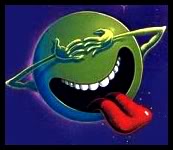 |
?There’s going to be a lot of debate-inducing nit-picking going on with this list, so I’m going to start you off easy. I actually understand why this one was left out of the film and its promotional materials. Douglas Adams notoriously hated the green space being (nicknamed the “Cosmic Cutie”) that was used on the cover art for various Hitchhiker’s releases. By not including it in the film, director Garth Jennings honored Adams’ beliefs that the Cutie should no longer be associated with Hitchhiker’s. However, given the fact that the movie constantly rushes through jokes and makes the Guide entries seem like an afterthought (more on these issues in a bit), it wouldn’t have been the film’s biggest slap in the face to Adams if the Cutie popped up on screen for a second in order to appease die-hards like myself who love the little guy.
14) “I’m a robot, not a refrigerator.”
For a clinically depressed robot, Marvin sure knows how to bring the lolz by whipping out a Star Trek reference. Relive the laughter for yourself by jumping to the 1:50 mark in the above video. Then remember that the film doesn’t actually include any discussion of how the Earth is “mostly harmless” and get enraged.
13) The Sirius Cybernetic Corporation Machines
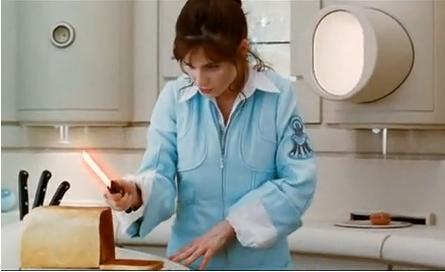 |
?An especially painful sequence in the film involves Trillian justifying her blowing off of Arthur by showing him the high-tech gadgets aboard the Heart of Gold. She first demonstrates the Nutrimat drink dispenser, which seems to work for her — even though moments before it produced a beverage that was almost, but not entirely, unlike tea for Arthur. Then with the presentational skills of a QVC host, she toasts bread with a knife that is so similar to a lightsaber you’ve got to wonder whether George Lucas was prepping a phone call to his intellectual property lawyer at some point. The main problem here is that these products actually work. At no point does Trillian say turn her arm into toast or give Arthur third degree burns. Part of the fun of Hitchhiker’s is witnessing the complete and utter ineptitude of the Sirius Cybernetics Corporation and the products they offer. By having the SCC products do what they are supposed to, their entire purpose for being in the story is completely neutered and their joke potential is lost.
12) It’s Visually Spectacular Yet Emotionally Hollow
Under the name of Hammer and Tongs, director Garth Jennings and producer Nick Goldsmith created visually spectacular music videos such as Blur’s “Coffee and TV” and R.E.M.’s “Imitation of Life.” When it was first announced that they would be the team bringing The Hitchhiker’s Guide to the Galaxy to theaters, even skeptics had to begrudgingly agree that, if nothing else, it would look terrific. And it truly does. What’s surprising though is empty and soulless the film feels. A lot of this can be attributed to the fact that this was Jennings’ first film and perhaps he didn’t know how to get better performances out of some of his actors. Anyone who watched the aforementioned Blur video — which relates the tale of a milk carton that goes in search of the missing man whose picture is imprinted on him — knows that Jennings is capable of generating real emotion from offbeat circumstances. So why couldn’t he here? I think a few things may be at play here, namely studio interference and bad editorial decisions. Whatever the reasons, the finished product really is visually superb. But with the exception of the Magrathea sequence, it never really begins to allow viewers to emotionally engage with what is happening on screen.
11) The Infinite Improbability Drive Sequence with the Woolen Dolls
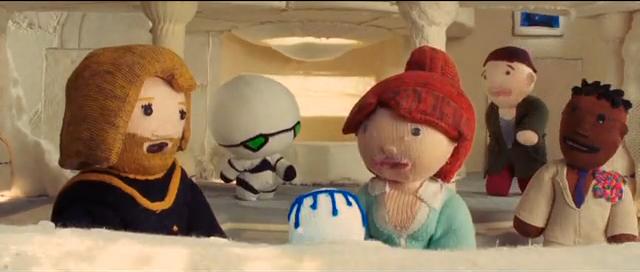 |
?Just so I’m clear, we were denied the opportunity to watch Ford turn into a penguin, but we did get to see the Heart of Gold crew transformed into Etsy refugees? That just doesn’t seem right, now does it? If I wanted twee preciousness I’d watch a Belle and Sebastian DVD, thank you very much.
10) The “So Long and Thanks for All the Fish” Musical Number
Having spent much of the past six years bitching about the flick to anyone who’ll listen, I’ve learned one thing: people love the musical number the opens the flick. “It’s got dolphins and is really cute!” is the response I get when I furrow my brow and get all stick-in-the-muddy about how I think the song plays like a low-rent outtake from Monty Python’s The Meaning of Life. I’m familiar with Adams’ link to the Pythons, and obviously have a love for the troupe. But I also think that Hitchhiker’s has such a unique voice of its own that the wannabe Python-esque qualities of “So Long and Thanks for All the Fish” do nothing more than devalue the humor inherent in Adams work. It feels like a studio decision to me, as if a Disney exec who didn’t understand the varied nuances of British comedy insisted that this opening be tacked on to up the humor value of the film by adding a madcap song. Worse still, it undermines the initial appearance of the Guide itself. This segment, accompanied by “Journey of the Sorcerer” (the Hitchhiker’s theme tune), shows up nearly twenty minutes into the film and feels like the true opening sequence. Yet in the aftermath of the dolphin tune a moment that should have been triumphant instead comes off as weird and disjointed.
9) The Vogons
Speaking of weird and disjointed, did anyone else feel that by focusing on the Vogons extreme bureaucratic nature the film missed a golden opportunity to explore the comedy inherent in all aspects of their personality? It was an interesting decision to be sure, but one I feel isn’t fully successful. Whereas the radio series, the books and the TV show all handled the Vogons as bureaucratic, it was never their sole trait before. Where is their callousness? Why did the filmmaker’s decide to feature the narration of the Guide entry on Vogon poetry over footage of Jeltz torturing Arthur and Ford with his prose? Where’s Jeltz carelessly slaying his underlings? These questions beg clarity that will never come. I realize and am fine with every permutation of the Hitchhiker’s story being its own thing, yet I have a problem with the saga’s one big bad being reduced to a one-note characterization here. Sigh. I should probably just realize that sometimes resistance is useless after all.
—-
8) Pointless New Characters
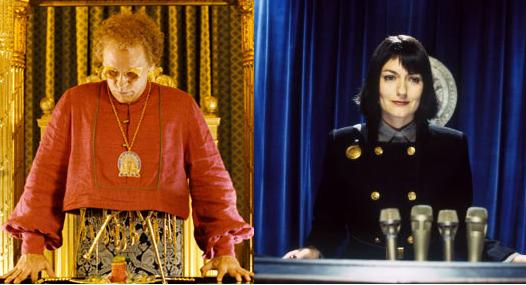 |
?When the movie came out, there was much hullabaloo about how the characters of Humma Kavula and Questular Rontok were original Douglas Adams creations. I am not the type of fanboy who blindly accepts everything Adams did as brilliant. But I do believe that there’s more to Kavula and Rontok than what the finished movie let’s us see. These characters as presented onscreen are complete ciphers, and their appearance does little more to fog up an already pretty complex/muddy narrative. I keep hoping that one of Adams’ completed scripts for the film leaks to the Internet at some point, so that we can see what their original purposes were to be. For now they remain little more than distractions from the characters that we really care about.
7) The Guide Entries (and Lack Thereof)
For a movie called The Hitchhiker’s Guide to the Galaxy, there is a surprising lack of actual Guide entries. Those that remain are mainly truncated (most notably the Babel fish one) or featured purely as voiceover narration. Since this list is really full of ranting, I will take a moment at this point to be uncharacteristically positive. The animation for the Guide entries (by music video production company Shynola) is superb. Disney should hire them to create an iPhone/iPad Guide app, because their entries are on par with the work that Rod Lord did on the original TV series. It’s just a damn shame that there aren’t more of them.
6) Whatever the Hell Is Going On with Zaphod’s Heads
Full disclosure: I actually think that Sam Rockwell’s performance as Zaphod is one of the film’s high points. I know this isn’t a hugely popular opinion, but I just thought I’d get this out of the way before I delve into my next tirade about the utter mishandling of Zaphod’s second head. In Robbie Stamp’s The Making of the Hitchhiker’s Guide to the Galaxy, it is revealed that original director Jay Roach came up with the idea of having Zaphod’s second head — whose brain contains the majority of his negative personality traits — in his neck. It would save money on CGI-ing a second head onto Sam Rockwell in every shot for sure, but at the cost of being extraordinarily ass. If the TV show could do it in 1981, there’s no reason why a big-budget motion picture couldn’t some 24 years later. As if this all wasn’t already shitty enough, then the movie seemingly gets bored of having the second head altogether, and loses it just before this bit of subconscious/and or meta criticism on the part of the filmmakers happens:
 |
?Note: The commentary featured above is new movie character Humma Kavula’s, not mine. Although I wholeheartedly agree…
5) Miscasting
I think the casting in Hitchhiker’s was mostly terrific (although in my mind, the perfect Arthur and Ford would be David Mitchell and Robert Webb respectively). Two notable exceptions are Mos Def and Zooey Deschanel. Before you cry racism in the comments, I have absolutely no problem with Ford Prefect being portrayed by an African-American actor. The problem is that Def’s take on the character is far too laid back and low-key, and the movie suffers because of it. You never get the sense of Ford’s wild or mischievous sides and no, that scene on Viltvodle VI where he enters the bar and everybody shouts his name a la Norm on Cheers doesn’t count. Like Def, I have seen some great acting in other projects from Deschanel as well, but her Trillian is embarrassingly bad. I hope Ben Gibbard doesn’t show up to my house to kick my ass for saying so (okay, I totally do because man I love me some Death Cab for Cutie) but Deschanel delivers the worst female sci-fi performance since Winona Ryder in Alien Resurrection and that is really saying something. We’re talking Jake Lloyd bad here. Since she has proven herself more than capable since, you have to question whether or not she just wasn’t directed properly. One thing that is certain is that the movie marks the most developed that the Trillian character has ever been. But I’m such an asshole I have a problem with this too. Why? Read on and see.
4) The Forced Love Story
To make the movie more palpable to mainstream audiences, the decision was made to expand the Arthur/Trillian dynamic into a typical Hollywood love story. The only time that a love story worked in the Hitchhiker’s saga was in So Long and Thanks for all the Fish, and most people would argue this opinion (including Douglas Adams, who jettisoned Fenchurch between the end of that book and the start of Mostly Harmless). As characterized in the film, Trillian is a woman suffering from either bipolar disorder or borderline personality disorder who encourages grounded guys to ditch their jobs and responsibilities to join her on ill-advised treks across the globe. When they don’t, she runs off with the first flake who will become her partner in misguided bohemianism. But you know what ultimately happens to people like Trillian? They beg you for change in the intersection while you drive to the bank to deposit your meager paycheck and wonder what the fuck became of your dreams. Getting back to my original point though, the love triangle (make that rectangle, what with Questular lusting after her boss and all) between Arthur, Trillian and Zaphod never works because what we are shown about why they are into each other never rings true. It feels forced because it simply is.
3) They Had Someone Unfamiliar with Hitchhiker’s Punch Up Douglas Adams’ Script
According to Neil Gaiman’s biography Don’t Panic, Adams handed in a completed script to Jay Roach in 2001 shortly before his death. In publicity interviews conducted around the release of the film, co-screenwriter Karey Kirkpatrick discussed how he was previously unfamiliar with Hitchhiker’s and the changes he made were done so in order to make Adams’ screenplay work cinematically. The fact that the screenplay is a mash-up of Adams and Kirkpatrick’s work helps to explain somewhat why the film is so tonally uneven. Yet the mysteries of what happened to the finished script that Adams worked on, why it wasn’t deemed good enough to be produced, and why a screenwriter more aware of the source material (Terry Jones anyone?) wasn’t brought in remain. It’s bad enough that Adams’ script was somewhat tossed, but then someone with NO PREVIOUS KNOWLEDGE OF THE STORY was brought in to, er, fix it. That just strikes me as being contemptuous to Adams and his fans.
2) It’s Not Especially Funny
The first cut of the movie was 2 ? hours long. This was whittled down to 110 minutes, which meant that a lot of things had to go in order to fit the new running time. Apparently, humor was the first thing trashed. I already discussed how the Guide entries suffered in the completed film, and many familiar scenes were hacked and slashed beyond recognition (ex- Arthur’s interactions with Mr. Prosser, the discussion of Slartibartfast’s name, etc) as well. Douglas Adams’ humor often lies in the big ideas he presented. While heavy on fan-wanking details like having Zaphod eat Star Bix cereal, the film often seems to have little interest in actually presenting humor in the intelligent manner that was the author’s trademark. It’s one thing to have Ford carrying around a towel, but when the information on why towels are so important is never conveyed to viewers new to the story a great comedic concept is reduced to an in-joke. While researching this article, I learned that Douglas Adams was apparently responsible for the decidedly un-Hitchhiker’s slapstick sequence on Vogsphere. It surprised me that such a broad sequence came from his mind given the fact that it didn’t feel like his style at all. After all, in the 1980s he decried Ivan Reitman’s aborted attempts to create a Hitchhiker’s Guide movie based on big jokes instead of the comedy grenades he was used to lobbying. Adams lamented several times during this period that Hollywood wanted nothing more than “Star Wars with jokes.” With him out of the way to protest, it looks like they finally got their chance.
1) A Shocking Misunderstanding of the Characters and Concepts That Made Hitchhiker’s So Great in the First Place
Fact: The Restaurant at the End of the Universe exists as a location in time rather than space. Given how often the filmmakers claimed they had nothing but a deep respect and understanding for Douglas Adams’ work such a major detail shouldn’t have been lost on them. This is a problem that plagues the film on a fundamental level. The fake deleted scene shown above pokes fun at fans fears of having Hitchhiker’s turned into a mainstream Hollywood action flick. But what Disney and Garth Jennings did with the finished product is far worse that what you see here. They’ve stripped bare the soul of Hitchhiker’s Guide, leaving behind a shell of a movie that strives for greatness but can barely muster up mediocrity. Now I know how Marvin feels.

